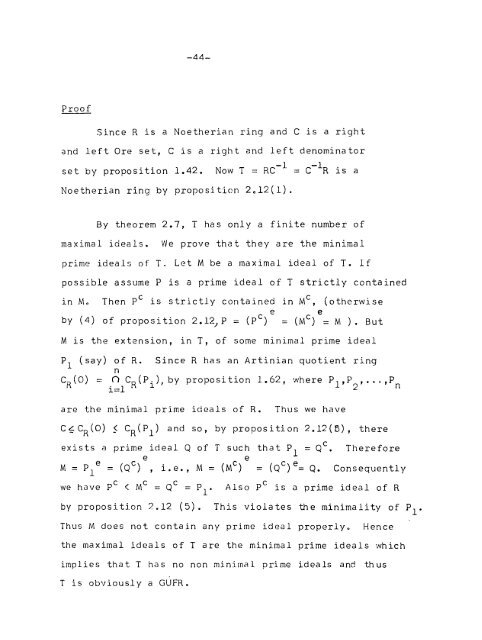Studies in Rings generalised Unique Factorisation Rings
Studies in Rings generalised Unique Factorisation Rings
Studies in Rings generalised Unique Factorisation Rings
Create successful ePaper yourself
Turn your PDF publications into a flip-book with our unique Google optimized e-Paper software.
-44-<br />
Proof<br />
S<strong>in</strong>ce R is a Noetherian r<strong>in</strong>g and C is a right<br />
and left Ore set, C is a right and left denom<strong>in</strong>ator<br />
set by proposition 1.42. Now T = RC- l = C-1R is a<br />
Noetherian r<strong>in</strong>g by proposition 2 012(1).<br />
By theorem 2.7, T has only a f<strong>in</strong>ite number of<br />
maximal ideals. We prove that they are the m<strong>in</strong>imal<br />
prime ideals of T. Let M be a maximal ideal of T. If<br />
possible assume P is a prime<br />
ideal of T strictly conta<strong>in</strong>ed<br />
<strong>in</strong> Mo Then pC is strictly conta<strong>in</strong>ed <strong>in</strong> MC, (otherwise<br />
o c e<br />
by (4) of proposition 2.12 JP<br />
= (pc) ~ = (M ) = M ). But<br />
M is the extension, <strong>in</strong> T, of some m<strong>in</strong>imal prime ideal<br />
P l<br />
(say) of R. S<strong>in</strong>ce R has an Art<strong>in</strong>ian quotient r<strong>in</strong>g<br />
n<br />
CR(O) = n CR(P.), by proposition 1.62, where P1,P , ... ,P<br />
i=l 1 2 n<br />
are the m<strong>in</strong>imal prime ideals of R. Thus we have<br />
C-fCR(O) 5- CR(P l)<br />
and so, by proposition 2.12(5), there<br />
c<br />
exists a prime ideal Q of T such that PI = Q. Therefore<br />
e<br />
e<br />
M = p e l<br />
= (Qc) , i.e., M = (Mc) = (Qc)e= Q. Consequently<br />
we huve pC < MC = QC = Plo Also pC is a prime ideal of R<br />
by proposition 2.12 (5).<br />
This violates the m<strong>in</strong>imality of Plo<br />
Thus M does not conta<strong>in</strong> any prime ideal properlyo Hence<br />
the maximal ideals of T are the m<strong>in</strong>imal prime ideals which<br />
implies that T has no non m<strong>in</strong>imal prime ideals and thus<br />
T is obviously a GUFR.
















